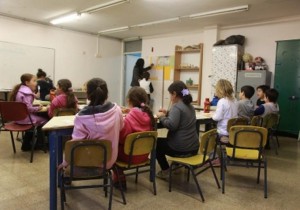The Israeli education system is in the midst of a slow process of reducing separation between Jews and Arabs, according to the annual Taub Center State of the Nation report released Wednesday.
The report found that the population of pupils attending mixed schools – those in which more than 1 percent of the pupils are Jews and more than 1% are Arabs – grew 59% from 68,000 in 2003 to 109,000 in 2013, representing 6% of all pupils in Israel and some 15% of those in state-run Jewish education.
During the same period, however, the population of pupils attending schools without any Arab students gained 9%, while the population of those attending schools without any Jews increased 33%.
“The buds of integration in Israeli education for the most part do not stem from any deliberate policy of the education system. Rather, they have sprouted from below, from the parents themselves and from the initiatives of organizations in civil society,” the report stated.
The report further found that this phenomenon has occurred, in part, due to the fact that numerous Arab families have moved into predominately Jewish neighborhoods in recent years, breaking down separations between the two groups. In addition, the report stated that there is a common perception among Arab parents that Jewish schools will provide better education for their children.
According to the report, in 2013 some 1.6 million pupils attended elementary and high schools in Israel, of which some 870,000 attended schools without even a single Arab student and almost 330,000 attended schools without even one Jewish child.
In contrast, some 395,000 pupils attended schools with at least one Arab or Jewish student – including some 5,600 Arabs attending Jewish schools and 360 Jews attending Arab schools.
With regards to the distribution of the 355 mixed schools in which Jews and Arab learn side-by-side, 94% belong to the Jewish sector whereby the share of Arabs is low – in 228 schools, Arab pupils account for less than 5% of the student body. Special education schools also account for a significant portion of the mixed schools – some 49 of the 228.
Analyzing the schools according to the socioeconomic level of the municipality further reveals that mixed schools are prevalent in middle and upper-middle class localities. It is important to note, however, that mixing is common mainly in the weakest neighborhoods of these various localities.
In contrast, in the poorest of municipalities, mostly Arab or ultra-Orthodox, there are no mixed schools.
Despite this growing trend in mixed schools, there is still a long way to go with regards to Arab and Jewish integration in the education system. There are only five bilingual schools and three such preschools in Israel that integrate Arab and Jewish pupils with the goal of promoting equality and coexistence.

